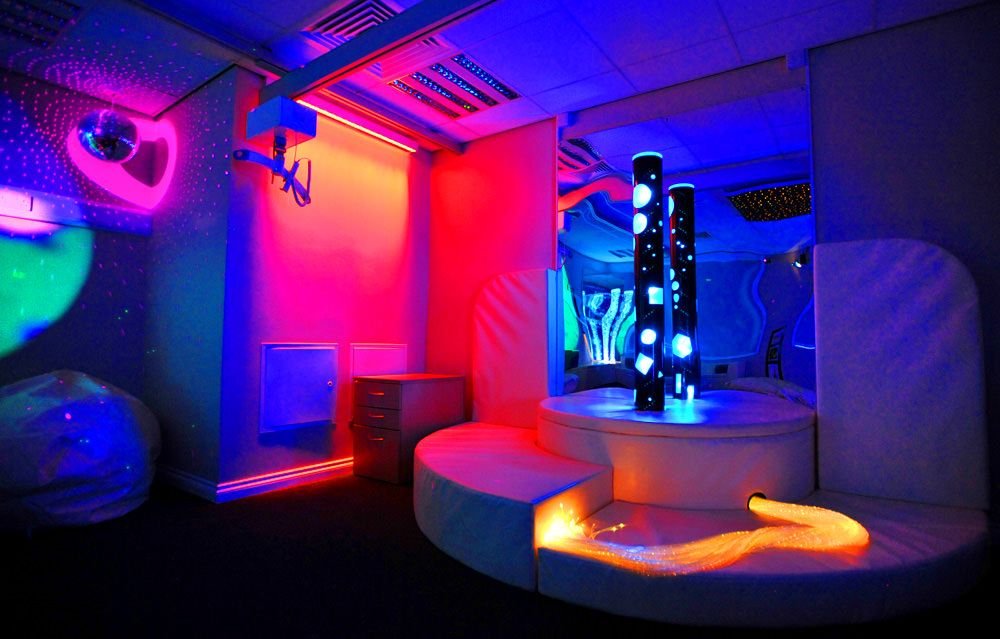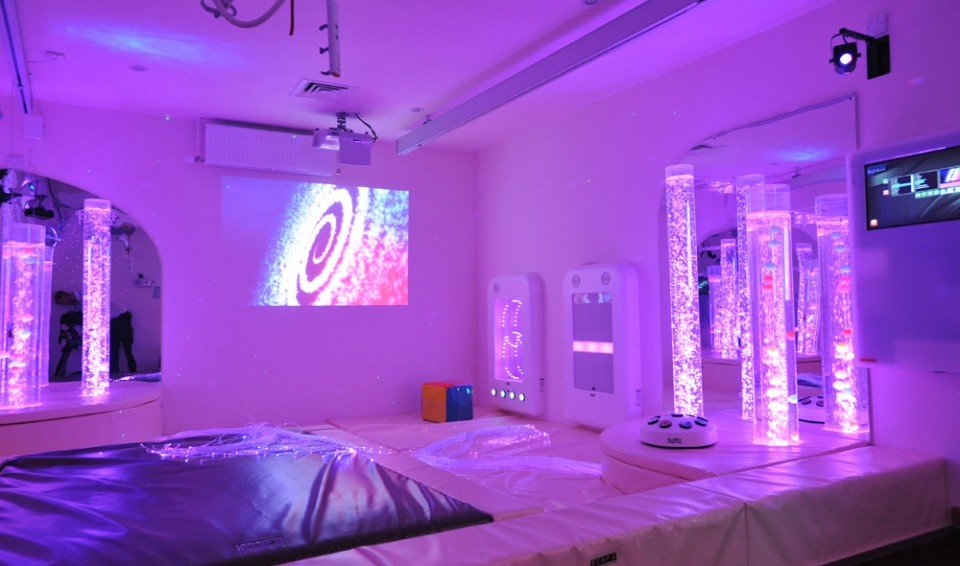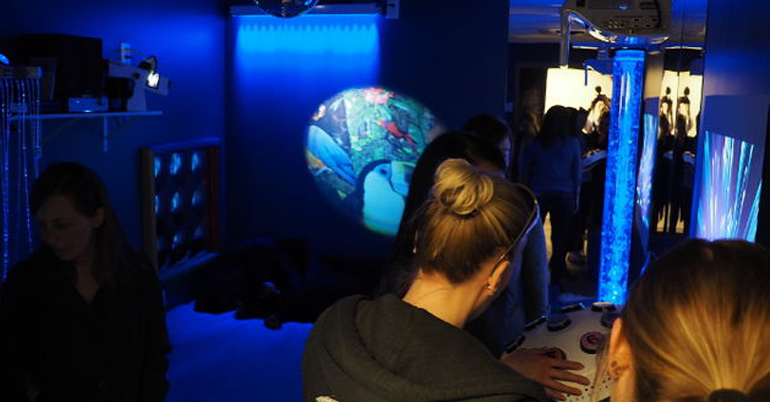In the 1970s, two Dutch therapists designed an unusual sensory environment for working with people with disabilities and named it Snoezelen ("snuzlen"). The word is coined from two Dutch words, snuffelen, meaning to sniff (explore) and doezelen, meaning to snooze.
Originally conceived as a safe environment and place of relaxation for people with disabilities, this multisensory space immediately showed many other advantages.
In addition to reducing restlessness and tension, it has also proven to be an environment that stimulates reactions to sensory stimuli, encourages communication, social interaction, research and learning.
The goal of the Snoezelen sensory room is that the person using the room has control and decides for himself which activities he wants to participate in, i.e. the individual needs of each person are respected, but without predetermined therapeutic goals.
Take a walk through the Snoezelen sensory room:
Virtual walk through the sensory room Snoezelen (theme: Space)
Let's remember that there are eight sensory systems: vision, hearing, smell, taste, touch, vestibular and proprioceptive systems (movement and position in space) and the interoceptive system that provides us with information about the internal state of our body. The Snoezelen room is designed to stimulate all these senses.
Here you can find different lamps and tubes with bubbles that change colors and stimulate vision, optical fibers that shape curtains or stimulate the sense of touch when held in the hands, and projectors that create interesting interactive scenes on walls, floors or ceilings and attract and retain attention. The sense of hearing is stimulated by music, sounds that can be activated by certain actions or materials of different textures that rustle and crackle when touched.

You can sit comfortably in the soft armchairs of different shapes or throw yourself into the pool with balls and imagine that you are swimming. In the pool with balls, vibrations can also be started, pleasant light can shine from the bottom or you can play soothing music. Activate different scents that evoke memories and feelings of comfort, look up into the imitation of clouds or play with the interactive panel on the wall. On that panel, you can throw out all the unpleasant feelings of that day and no one will be angry. The possibilities are endless!

Who can the Snoezelen sensory room help?
The Snoezelen sensory room is not only for passive observation of the listed effects, but also for participating in the game, creating your own games and research. Those who cannot participate in multisensory play using their hands or feet can use gaze control, pressing switches, and various other methods of interaction. The Snoezelen sensory room is also accessible to blind and partially sighted people.
And finally, the most important thing to remember is that this room does not set limits. It is suitable for users of all ages and ability levels. That's why below we present just a few examples where the Snoezelen multisensory environment can be of great use.
Snoezelen Sensory Room and Autism Spectrum Disorders
Autism spectrum disorders cover a really wide range of difficulties and stories of completely different individuals. The Snoezelen sensory room (i.e. multisensory environment) can be changed and adapted to each of them, making it special and invaluable in work and therapy. It goes without saying that for people with autism spectrum disorders, the environment they are in plays a big and significant role.
Both hypo and hypersensitive people can feel comfortable in the Snoezelen room; light, noise level, colors - all this can be changed and adjusted. When necessary, sensory stimuli can be moderated, controlled, and gradually enhanced, while at other times, selected sensory stimuli can be amplified or isolated to the exclusion of all others, so that the person can focus attention on them. In this way, we create a safe environment for assessments, and later interventions and work with a therapist, in which children and adults will not feel tension, fear or discomfort. The Snoezelen sensory room is therefore not only an environment, it is also a large collection of tools for assessment, therapy, stimulation, play and learning.

Snoezelen sensory room and intellectual disabilities
Research shows positive results after using the Snoezelen sensory room in a therapeutic approach. Therapy with the help of the Snoezelen sensory room significantly contributes to reducing undesirable and increasing desirable behaviors in people with intellectual disabilities. Desirable behaviors are generalized to their everyday life.

Snoezelen sensory room and work with behavioral disorders
For many people, who find it difficult to cope with the problems and demands of the environment, the responses are often manifested through the expression of emotions in ways that society considers unacceptable. There are different types of undesirable behaviors, and people who exhibit them can often pose a danger to themselves and others.
Therapy for people with disorders in the Snoezelen room takes place in a soothing multisensory environment. In contrast, the paneled walls and mats on the floors are there for those who might want to channel their negative emotions without hurting themselves.

For some, other activities in which they can expel negative emotions, such as interactive panels on the walls, will suit them. One such example is a "cardioside" that can be hit and that encourages activity to simultaneously improve coordination and motor functions, as well as focus on a specific task.
Snoezelen sensory room and occupational therapy
In occupational therapy, the multifunctionality of the Snoezelen sensory room comes to the fore. It easily adapts to every individual, from small children to the elderly, as well as to people with various motor or cognitive disabilities. This multisensory space can be used to assess the individual's abilities, but also for work and rehabilitation.
In the Snoezelen sensory room, for example, simple activities can be performed while avoiding sensory overload, such as focusing attention on a single task or exercises to improve attention and concentration. This is done by turning off all other equipment except the one you are currently working with. More complex activities can be performed, such as learning self-regulation techniques or performing everyday tasks.
The activities can be easily adapted to the different needs of occupational therapy, for example the color or size of objects for people who have vision problems, sound for people who are hard of hearing or sensitive to loud sounds or certain sounds. Children can also bring their favorite toys that can become part of the game. An incentive for some activity can also be the activation of a personalized sound or light effect, in which projectors help a lot.

Snoezelen sensory room and early intervention
At an early age, receiving sensory stimuli and learning through play is of great importance. Under the influence of sensory stimuli from the environment, synapses are created between neurons, which is important for understanding the world around us, reacting to stimuli, developing personality and making decisions.
Through play in the Snoezelen sensory room, motor skills are developed, the understanding of cause and effect is learned, and the assessment of the child is incomparably easier in this informal environment. The pleasant atmosphere of the Snoezelen sensory room reduces the pressure on the child, so it is easier to notice things that might go unnoticed in the formal environment of an office or doctor's office.

Snoezelen sensory room and dementia
Recent research shows that the Snoezelen sensory room has the potential to reduce feelings of restlessness and improve mood in people with dementia; the effectiveness is visible in the improvement of the results of occupational therapy, easier coping with the perception of pain and increased involvement and social interaction, which positively affects the quality of life and care of the user .
In sensory rooms, people with dementia can explore and stimulate all five senses in a safe environment. In them, people can be calmed down or stimulated, depending on their needs. Combinations of light, movement, music and tactile objects can stimulate a sense of comfort and well-being, relieve stress and pain, and increase a person's concentration. All of the above can facilitate memory and communication for people with dementia. There is also the possibility of individualizing the sensory room in such a way that it is enriched with familiar objects from everyday life, interesting smells and textures, natural materials, sounds and visual stimuli.
A sensory room can improve mood, boost confidence and promote a sense of well-being, not only for people with dementia, but also for people who have suffered brain injuries or suffer from chronic pain.
Here, the sensory rooms are used in a number of ways; to create a pleasant and safe therapeutic environment or to stimulate the senses with visual, auditory, tactile and olfactory stimuli. The Snoezelen sensory room is also an ideal place for learning new communication techniques and all forms of sensory integration therapy.
When designing a sensory room for the purpose of rehabilitation, attention should be paid to inclusivity. It is necessary to think carefully whether its contents are available to everyone; people who move without difficulty, people in wheelchairs and people who move with the help of a walker. The arrangement in the Snoezelen room must be such that the users can be lifted up and carried safely, and that they can be placed comfortably and safely everywhere. They must have easy access to the equipment, have a good view of all the elements of the sensory room and use them without difficulty.

Individuals recovering from brain injury can benefit from specially designed cognitive training activities that include problem solving, decision making, hand-eye coordination, concentration, memory, focused attention, object recognition, and word retrieval. Smaller interactive objects or games that can be easily transported and used in different positions can be used to develop muscle strength, grip or different movements.
How to get to the sensory room?
E-Glas will guide you through the entire process from the beginning to the final realization and provide answers to all your questions. Also, E-Glas offers you a FREE consultation and 3D design service for a sensory room in your school, center or home.
Find out how to get to the sensory room in 7 steps!
Have you watched the video "How to a sensory room in 7 steps" and want to immediately solve the first and second steps described in the video? All you need to do is click on "Request a quote", then fill out our form and we will contact you.
